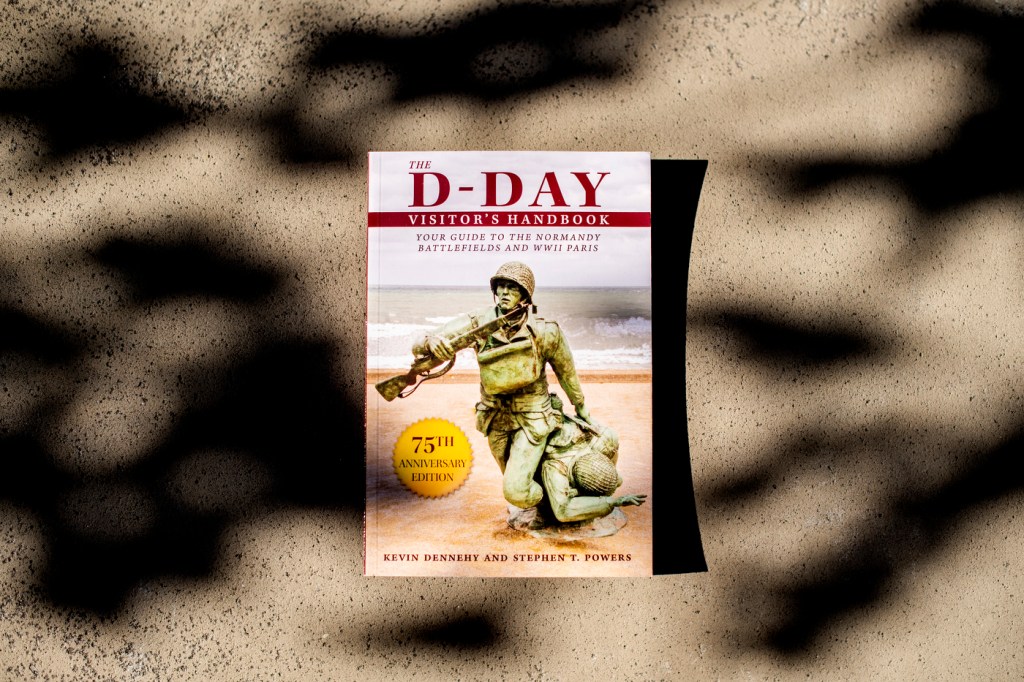Here’s a guide to D-Day that helps you navigate the beaches of Normandy

From your pathway to the cemetery, where 9,386 grave markers commemorate the lives that were lost to help save the world, you can see the familiar green cliffs and the infamous beach that was code-named “Omaha” 75 years ago. Greeting you there on the warmest days are wind-surfers and dog walkers, young families emerging from white changing huts, and condo developments erected for the water views.
“In the summertime, you see a lot of people sunbathing on a beach that thousands of Americans died on,” says Kevin Dennehy, a Northeastern student who will be addressing the university’s Student Veterans Organization on Wednesday. “It’s kind of disconcerting for Americans to see that sometimes.”
Bringing coherence to one of the world’s most important battlefields is a guidebook written by Denney and Stephen Powers, The D-Day Visitor’s Handbook: Your Guide to the Normandy Battlefields and WWII Paris.

Northeastern student Kevin Dennehy is co-author of The D-Day Visitor’s Handbook: Your Guide to the Normandy Battlefields and WWII Paris. Photo by Matthew Modoono/Northeastern University
The invasion of Normandy on June 6, 1944, the largest seaborne invasion in history, enabled American-led forces to break through the German front in the West. The landing beaches are, writes Dennehy, “the holy grail of World War II sites.”
The book provides maps of the battlefields with information on the best museums, monuments, and other historical sites. Dennehy, a Special Forces combat veteran in Afghanistan and Iraq who retired as a colonel in the National Guard, developed the idea when he made his first visit to the D-Day sites in 2007.
“I didn’t know where to go and there wasn’t any guidance—you couldn’t check out a book that told you how to get around,” Dennehy says. “I approached one of my old professors and said, ‘Hey, let’s write a book.’”
Dennehy and Powers, who taught history at the University of Northern Colorado for more than 30 years, originally self-published the book for the 70th anniversary of D-Day in 2014. They returned to France three years later in order to update the book with a publisher, Skyhorse, for the 75th anniversary last summer.
“It was a bad intelligence failure for us to land at Omaha, and it’s very sad,” Dennehy says. “The Allies didn’t do an effective bombing campaign. The bombs were dropped too high in the air, and then the naval gunfire was very short. They didn’t learn their lessons from the Pacific battles they had fought less than a year before Omaha.”
Dennehy and Powers are working on a new book of interviews with veterans who survived famous battles during World War II. They have also published books on World War I and George Custer’s battle of the Little Bighorn.
Dennehy has had several careers concurrently. In addition to his three decades in the military reserves, he practiced criminal law for a dozen years, and has worked in journalism for more than 30 years. He is currently pursuing a master’s degree in digital media at Northeastern to help him develop and market his work for the new era of journalism.
Dennehy will be speaking Wednesday at 6 p.m. at the Dolce Center for the Advancement of Veterans and Servicemembers on 271 Huntington Ave., Room 277.
“My presentation to the Student Veterans Organization won’t just be about the book,” says Dennehy, who is a member of the organization. “It will also be about how veterans can write not just their own stories, but also get involved in free-lance writing or writing a book of their own. As long as you have a good network and digital marketing skills, it can be a good side hustle.”
For media inquiries, please contact media@northeastern.edu.






